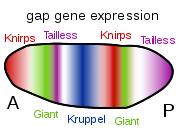Portal:Evolutionary biology
 In evolutionary biology, punctuated equilibrium (also called punctuated equilibria) is a theory that proposes that once a species appears in the fossil record, the population will become stable, showing little evolutionary change for most of its geological history. This state of little or no morphological change is called stasis. When significant evolutionary change occurs, the theory proposes that it is generally restricted to rare and geologically rapid events of branching speciation called cladogenesis. Cladogenesis is the process by which a species splits into two distinct species, rather than one species gradually transforming into another. Punctuated equilibrium is commonly contrasted with phyletic gradualism, the idea that evolution generally occurs uniformly by the steady and gradual transformation of whole lineages (anagenesis). (Full article...) The following are images from various evolutionary biology-related articles on Wikipedia.
 The last known Thylacine photographed at Hobart (formerly Beaumaris) Zoo in 1933. A scrotal sac is not visible in this or any other of the photos or film taken, leading to the supposition that "Benjamin" was a female, but the existence of a scrotal pouch in the Thylacine makes it impossible to be certain

WikiProjects connected with biology: A complete list of scientific WikiProjects can be found here. See also Wikispecies, a Wikimedia project dedicated to classification of biological species. Discover Wikipedia using portals |






























![Image 31A covalent adduct between the metabolite of benzo[a]pyrene, the major mutagen in tobacco smoke, and DNA (from Mutation)](http://upload.wikimedia.org/wikipedia/commons/thumb/d/d8/Benzopyrene_DNA_adduct_1JDG.png/130px-Benzopyrene_DNA_adduct_1JDG.png)















